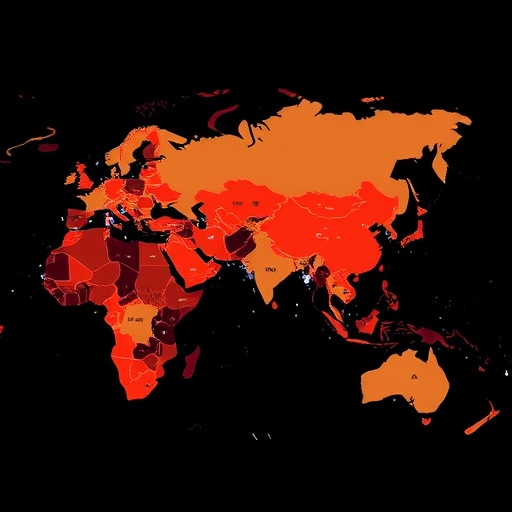In an era marked by rapid demographic and social changes, schizophrenia continues to pose a substantial challenge to global mental health. A recent comprehensive study published in BMC Psychiatry meticulously charts the temporal evolution of schizophrenia’s burden from 1990 and projects its trajectory through 2030, offering a critical comparison between the global landscape and the specific context of China. This rigorous analysis harnesses data from the 2021 Global Burden of Disease Study, delivering unprecedented insights into the incidence, prevalence, and disability-adjusted life years (DALYs) attributable to schizophrenia.
The investigation reveals that as of 2021, approximately 13.6 million individuals worldwide were living with schizophrenia, corresponding to an age-standardized prevalence rate of 275.78 per 100,000 population. This figure underscores schizophrenia’s persistent and widespread impact on diverse populations across continents. The incidence rate, indicative of new cases arising within a given time frame, was estimated at 1.20 million globally, translating to about 15.43 per 100,000 people. Concurrently, the assessed DALYs, which measure both years lost due to premature death and years lived with disability, amounted to roughly 14.8 million worldwide, reflecting the profound and multifactorial toll schizophrenia exacts on individuals and societies.
China, a country whose population dynamics significantly influence global health statistics, exhibited noteworthy trends within this period. The prevalence of schizophrenia in China reached an estimated 5.3 million cases in 2021, positioning the age-standardized rate markedly higher at 300.81 per 100,000 individuals. Incidence counts stood at approximately 236,175 new cases, equating to 18.36 per 100,000—surpassing the global rate. Meanwhile, DALYs attributable to schizophrenia in China amounted to 3.4 million, with a rate of 203.88 per 100,000, spotlighting the heightened disability burden faced locally.
Trends over the past three decades reveal nuanced dynamics. China’s age-standardized prevalence and DALY rates have incrementally increased, with estimated annual percentage changes (EAPCs) of 0.12 and 0.04, respectively. This signals a subtle yet consistent rise in disease burden over time. Globally, however, a contrasting pattern emerges: the age-standardized incidence rate exhibits a slight decline, with an EAPC of -0.04, indicating marginal reductions in new cases at a worldwide scale. These divergent trajectories underscore the complex interplay of socioeconomic, healthcare, and environmental factors shaping schizophrenia’s epidemiology.
To cast light on future directions, the research team applied sophisticated modeling techniques, employing joint point analysis alongside Bayesian age-period-cohort (BAPC) models. Such models integrate age-specific, temporal, and cohort-related variables to predict forthcoming epidemiological patterns with enhanced precision. Projections charted through 2030 forecast an upward trend in schizophrenia prevalence, incidence, and DALYs both globally and within China, flagging an intensifying public health challenge.
By 2030, the global age-standardized prevalence rate is anticipated to escalate to approximately 280.36 per 100,000, with incidence increasing to 15.59 per 100,000, and DALYs subtly declining to 177.31 per 100,000. China’s situation is projected to intensify further, with prevalence rates climbing to an alarming 332.58 per 100,000, incidence rising to 19.87, and DALYs soaring to 216.67 per 100,000, signaling a disproportionate and accelerating burden. These projections highlight a pressing need for strategic public health interventions tailored to both global and country-specific contexts.
The implications of these findings are manifold. Schizophrenia’s expanding burden, particularly in China, mandates urgent actions encompassing mental health promotion, early identification, and targeted therapeutic strategies. The study stresses prioritizing young adults aged 20 to 34, a demographic bearing substantial disease incidence, and underscores the necessity for gender-sensitive approaches—especially enhancing support services tailored for men who historically face higher schizophrenia morbidity.
Further, the research advocates for bolstering mental health education to dismantle stigma and improve community awareness, which are critical for timely diagnosis and intervention. Strengthening mental health infrastructure with specialized treatment and rehabilitation pathways is paramount for addressing the complex needs of affected individuals. Equally important is the call for policymakers to optimize resource allocation based on robust epidemiological data, ensuring equitable access to mental health services for high-risk populations.
As schizophrenia’s societal and familial impacts mount, integrating these predictive insights into mental health planning frameworks offers a pathway to more effective, evidence-driven policies. The study represents a clarion call for global health systems to adapt and respond proactively to these forecasted trends, leveraging multidisciplinary collaboration to mitigate schizophrenia’s multifaceted burdens.
In summary, this landmark study not only illuminates the contours of schizophrenia’s current global and Chinese burden but also delineates foreseeable challenges over the next decade. The convergence of epidemiological data, advanced predictive models, and focused recommendations provides stakeholders with a comprehensive roadmap to confront one of psychiatry’s most enduring and debilitating disorders. Sustained commitment to research, prevention, and care will be pivotal in changing the trajectory of schizophrenia’s profound impact worldwide.
Subject of Research:
Assessment and projection of the global and Chinese burden of schizophrenia from 1990 to 2030, including incidence, prevalence, and disability metrics.
Article Title:
Global burden and prediction study of schizophrenia 1990–2030: comparison with China.
Article References:
Yuan, Z., Bai, C., Li, Y. et al. Global burden and prediction study of schizophrenia 1990–2030: comparison with China. BMC Psychiatry 25, 955 (2025). https://doi.org/10.1186/s12888-025-07168-6
Image Credits: AI Generated




